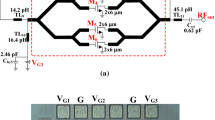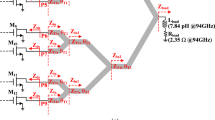Abstract
Two W-band CMOS elliptical baluns (i.e. balun-1 and balun-2) for 94 GHz image radar, and one miniature Ka-band CMOS square balun (i.e. balun-3) with short-terminal and input capacitor (for elimination of the inductive imaginary part of the input impedance at the input port) for 28 GHz 5G communication system are demonstrated. These baluns are applicable to a down-conversion mixer for conversion of the single RF and LO input signals to differential signals. They are also applicable to a phase shifter for conversion of the single I and Q signals (from the quadrature coupler) to differential I (i.e. I + and I −) and Q (i.e. Q + and Q −) signals. Instead of the traditional balun structure that uses three sections of thin M5 (or M8) interconnection lines (underneath the thick top M6 (or top M9) main structure), the proposed balun structures use only one section of thin M5 (or M8) interconnection line to enhance S21 and S31. Balun-2 (with M9 main structure thickness of 3.4 μm) attains S21 of − 4.98 to − 4.57 dB, S31 of − 4.85 to − 4.59 dB, amplitude imbalance magnitude (AIM) smaller than 0.15 dB and phase difference deviation (PDD) smaller than 4° for 90–100 GHz. Balun-3 (with M6 main structure thickness of 2.34 μm) occupies a small chip area of 0.042 mm2, and achieves S21 of − 4.97 to − 4.44 dB, S31 of − 4.68 to − 4.29 dB, AIM smaller than 0.28 dB and PDD smaller than 2.3° for 27–29 GHz. The prominent results of these baluns indicate that they are suitable for W-band and Ka-band systems.













Similar content being viewed by others
References
Chiang, M. J., Wu, H. S., & Tzuang, C. K. C. (2009). A compact CMOS Marchand balun incorporating meandered multilayer edge-coupled transmission Lines. In IEEE international microwave symposium (IMS) (pp. 125–128).
Liu, J. X., Hsu, C. Y., Chuang, H. R., & Chen, C. Y. (2007). A 60-GHz millimeter-wave CMOS Marchand balun. In IEEE radio frequency integrated circuits (RFIC) symposium (pp. 445–448).
Chen, J. C., Chang, T. Y., & Chiang, Y. C. (2017). A V-band power amplifier using Marchand balun for power combining in 90-nm CMOS process. In IEEE wireless power transfer conference (WPTC) (pp. 1–4).
Yang, G., Wang, K., & Wang, Z. (2017). 20.8–51 GHz highly balanced CMOS balun. Electronics Letters,53(17), 1202–1203.
Lin, Y. S., Wen, W. C., & Wang, C. C. (2014). 13.6 mW 79 GHz CMOS up-conversion mixer with 2.1 dB gain and 35.9 dB LO-RF isolation. IEEE Microwave and Wireless Components Letters,24(2), 126–128.
Lin, Y. S., Lee, J. H., Huang, S. L., Wang, C. H., Wang, C. C., & Lu, S. S. (2012). Design and analysis of a 21–29 GHz ultra-wideband receiver front-end in 0.18 μm CMOS technology. IEEE Microwave Theory and Techniques,60(8), 2590–2604.
Wang, Y., & Lee, J. C. (2018). A miniaturized Marchand balun model with short-end and capacitive feeding. IEEE Access,6, 26653–26659.
Pozar, D. M. (2012). Microwave engineering. Hoboken: Wiley.
Lin, Y. S., Chang, J. F., Liang, H. B., Wang, T., & Lu, S. S. (2007). High-performance transmission-line inductors for 30–60 GHz RFIC applications. IEEE Transactions on Electron Devices,54(9), 2512–2519.
Chen, H. K., Lin, Y. S., & Lu, S. S. (2010). Analysis and design of a 1.6–28 GHz compact wideband LNA in 90 nm CMOS using a π-match input network. IEEE Transactions on Microwave Theory and Techniques,58(8), 2092–2104.
Lin, Y. S., Chen, C. Z., Yang, H. Y., Chen, C. C., Lee, J. H., Huang, G. W., et al. (2010). Analysis and design of a CMOS UWB LNA with dual-RLC-branch wideband input matching network. IEEE Transactions on Microwave Theory and Techniques,58(2), 287–296.
Acknowledgements
This work is supported by the National Science Council of the R.O.C. under Contracts MOST108-2221-E-260-015-MY3 and MOST108-2221-E-260-016-MY3. The authors are also very grateful for the support from Taiwan Semiconductor Research Institute (TSRI) for chip fabrication and high-frequency measurements.
Author information
Authors and Affiliations
Corresponding author
Additional information
Publisher's Note
Springer Nature remains neutral with regard to jurisdictional claims in published maps and institutional affiliations.
Rights and permissions
About this article
Cite this article
Lin, YS., Lan, KS. Design and analysis of CMOS baluns for 94 GHz image radar and 28 GHz 5G communication system. Analog Integr Circ Sig Process 103, 435–450 (2020). https://doi.org/10.1007/s10470-020-01616-x
Received:
Revised:
Accepted:
Published:
Issue Date:
DOI: https://doi.org/10.1007/s10470-020-01616-x




